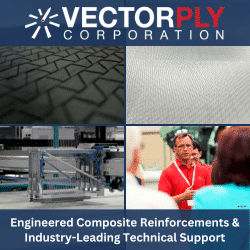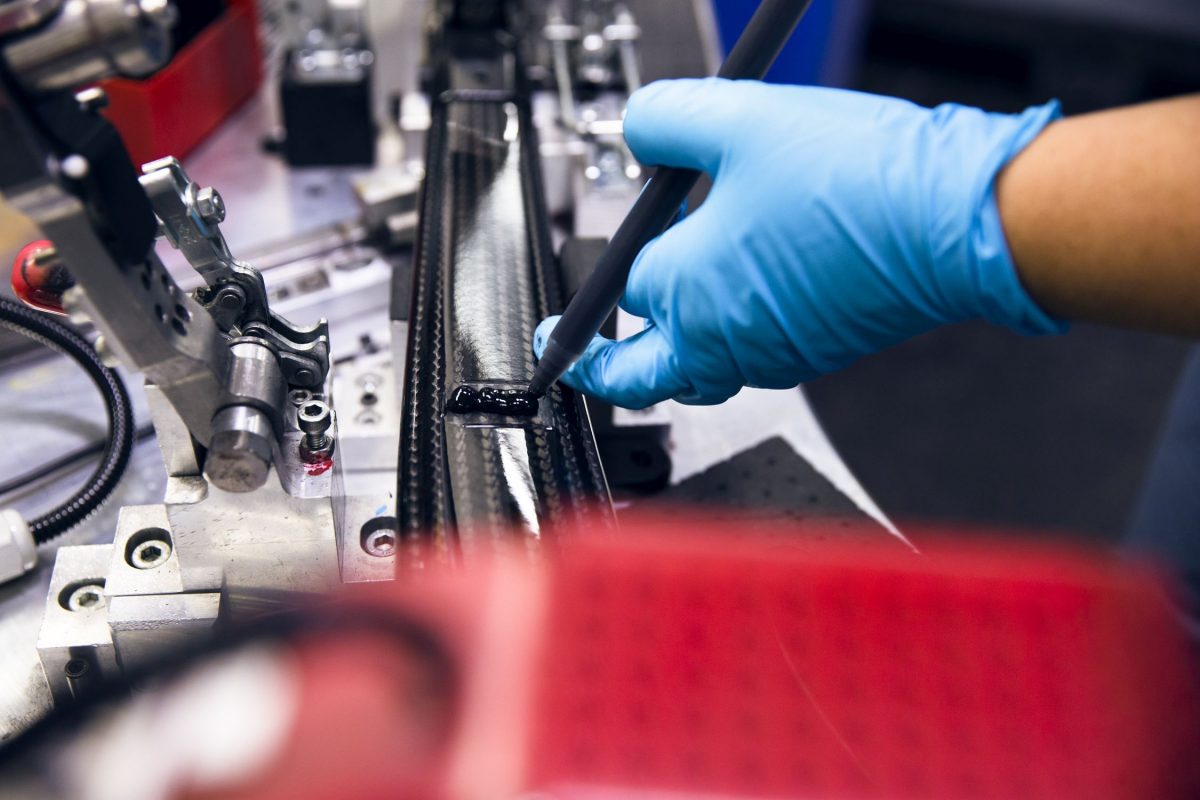

Graphene Gains Traction
Gaining widespread acceptance for a new material can be a slow process. But that’s not been the case with graphene, which appears to be on a fast track to adoption in the composites industry.
Graphene, first produced less than two decades ago, is the thinnest known material. For commercial purposes, it’s defined as one to 10 layers of sp2 carbon-bonded atoms in a hexagonal honeycomb lattice. Graphene is 100 to 300 times stronger than steel, making it the strongest material ever measured. When incorporated into an FRP composite material, a miniscule amount of graphene can make a substantial difference in its properties.
“We have comparative studies where the load factor for graphene goes from .9% to .5% to .01% that still makes a 35% to 45% improvement in the mechanical properties of the composite,” says Terrance Barkan, executive director of The Graphene Council, which is leading efforts to encourage the use of graphene for commercial applications.
A Classification Framework
Initially there was only one way to produce graphene, but today there are more than a dozen manufacturing processes that use feedstocks ranging from graphite and carbon-bearing gases to biochar, oil and coal. This has increased graphene’s availability but has also caused confusion for some potential users. There’s been no effective way for them to differentiate among graphene products from various producers.
The Graphene Council has developed and recently released a solution – the Graphene Classification Framework.
“The framework is a consistent, generic way of describing any form of graphene material using approximately 19 key characteristics that are relevant for commercial applications,” Barkan explains. For example, one graphene product might be described as a mechanically exfoliated graphite, three to five layers in thickness, that is non-oxidized and non-functionalized.
“It’s not a replacement for the full characterization, but having that descriptor gives you a pretty good idea of what material you’re dealing with,” he adds.
The framework provides a template for a technical data sheet that producers can fill out to provide in-depth characterization of their graphene.
Equipped with this information, companies interested in using graphene will be able to find multiple sources for specific types of graphene material and have confidence that all the products will have consistent properties and characteristics. In addition, the Graphene Classification Framework will enable health and safety regulatory agencies, which must approve graphene’s use, to differentiate among various types of the material.
An ISO working group is also reviewing the framework with the goal of adapting it to create an international graphene standard.
Automotive Applications
Graphene producers have been working closely with manufacturers to incorporate the nanomaterial into composite materials. Manufacturers of some high-end products have been including graphene in their mixes, but the graphene industry strives for wider usage.
Versarien PLC, based in Gloucestershire, United Kingdom, has significantly increased production of its graphene powder products over the last two years, including its flagship product Nanene™, hoping to expand the graphene market into larger-volume, lower-priced applications.
“Five years ago, we were producing a few grams a week. We’re now up to 10 tons a year, and probably in the next year or so we’ll be tenfold that,” says Jim Barnett, Versarien’s head of program management.
The automotive industry is a potential large-volume customer. In one demonstration project, Versarien’s subsidiary, 2-DTech, worked with Lotus Cars, University of Sheffield’s Advanced Manufacturing and Research Centre (AMRC) and several composite supply chain companies to produce a graphene-enhanced CFRP hood for the Lotus Evija electric sports car. By determining the optimal amount of graphene to include in the prepreg resin for the hood, the group improved the component’s mechanical performance by 10% and produced a surface that met Lotus’ paint specifications.
Graphene’s multi-functional nature makes it useful for a variety of automotive parts, says Steve Hodge, chief technology officer at Versarien. Graphene-enhanced composites could be used for a vehicle’s structural panels and interior parts, where the nanomaterial’s high thermal decomposition temperature could also reduce fire risk.
“Graphene has good electrical performance, high mechanical strength, good thermal conductivity and optical properties. It's a chemically robust material; it doesn't degrade until you get to very high temperatures. We can actually modify the chemistry of the surface quite easily to make it more compatible with certain resin systems,” says Hodge. “So really, it's like a toolkit that enables us to modify and enhance any composite material.”
He believes automotive companies and composites manufacturers will be more likely to incorporate graphene into vehicle components once they feel confident that graphene producers can deliver the nanomaterial in the quantity and at the consistent performance levels they require.
Graphene-Enhanced SMC
In 2021, graphene producer NanoXplore opened a fully automated production plant in Montreal that makes two grades of graphene powder using a liquid exfoliation process. The company also operates a composites business unit that manufactures finished parts, primarily for the heavy-duty truck and bus industry. Tarek Jalloul, the company’s technical project lead, says that vehicles with graphene-enhanced SMC exterior panels should be available commercially within the next few months.
The company is working with an industrial partner to produce a proprietary graphene-enhanced SMC compound that it will use to manufacture composite parts, as well as brand and sell under the NanoXplore trademark to other molders.
The main value proposition for transportation customers is lightweighting. NanoXplore maintains the same fiber loading levels in the SMC as it previously had and adds graphene to further improve the mechanical properties. That enables automotive suppliers to produce lighter, thinner parts without diminishing their strength.
“OEMs get to use less SMC material to produce parts of equal performance at a cost-neutral point,” says Jalloul. The inclusion of graphene also encourages better flowability of the material within the mold, enabling the creation of more complex geometric shapes, and provides an aesthetically improved surface finish with better weatherability performance.
Understanding the best method to disperse the graphene into the SMC is key to getting the desired results. “There are multiple ways of dispersing powders into resin systems that are very well known. The tricky part is figuring out the process parameters: What are the steps? Where do you put it in? How long do you process it for? It’s the details of the process that are unique,” says Jalloul.
Functionalizing the Additive
MITO Materials doesn’t produce graphene. Instead, the company functionalizes or enhances it. Functionalization involves adding other elements to the graphene to improve its solubility, enhance its strength or improve its bonding to a host matrix material.
MITO initially functionalized graphene oxide with an epoxide polyhedral oligomeric silsesquioxane (POSS®) to produce its E-GO product.
“We give the graphene a chemical bath and use the points on the graphene oxide to attach the POSS, then we filter it and dry it. The use of POSS helps ensure a good dispersion of graphene in the polymer system and helps impart the strength, energy dispersion, toughness and durability of the material,” says Hailey Keith, who co-founded the company with her husband Kevin.
At a concentration of just 0.1% of the polymer’s weight, the functionalized graphene can boost the performance of both thermoset and thermoplastic composite materials between 20% and 135% above baseline. With functionalized graphene, manufacturers may be able to get a cheaper resin to perform as well as or even better than a more expensive resin, according to the company.
One sporting goods manufacturer is already selling skis that incorporate MITO’s E-GO graphene.
“Folsom Custom Skis did field tests with us for six months, making three pairs of skis with 10 grams of E-GO per ski, which came out to about a 1% concentration,” says Kevin Keith. “They found that they not only increased flex strength by 35% but also increased the dampening properties of the skis by 100%.” Addling graphene also reduced the weight of the skis by 20%.
MITO is currently working with a large, national semi-trailer manufacturer that is transitioning from a combination of steel and composite trailers to fiber-reinforced composite trailers. “They're able to shed about 35% of the trailers’ original weight just by moving to an all-composites floor and sidewalls,” Kevin Keith explains. “The problem with the esters is that they don't have the same wear properties as the metals; even the custom formulations from their resin supplier wouldn’t meet specs.”
The manufacturer is currently testing FRP components made with the functionalized graphene. The results have been promising so far, and the manufacturer may eventually be able to transition to an all-composite trailer.
“Assuming just half the U.S. fleet adopts this significantly lighter trailer, which has the same load capacity, it would save $12 billion in fuel each year and save 57 million metric tons of CO2 from entering the atmosphere,” Keith says.
Optimized for Every Application
Calculating the right amount of graphene to include in a composite material is a balancing act. While a certain percentage of graphene might provide optimal mechanical properties to a composite material, a higher percentage may be required if the customer wants to take advantage of its electrical properties as well.
“We have to work with customers quite closely to find a solution, and we often have to make compromises. You have to optimize each system one by one,” Hodge says. Versarien has developed a large database of how graphene works with various polymers that can help customers determine how well the nanomaterial would work for their application.
MITO has developed similar reference materials. “What we found missing for graphene was a bridge into composites. Clients need to understand how graphene is going to interact and integrate into different host materials, what properties and challenges they can expect or what they can solve for within these different polymers,” says Keith.
Adoption Across Industries
Graphene is not a miracle additive; adding it to a composite won’t automatically solve every problem that a manufacturer has with a particular composite component. But as more graphene materials become available at different price points and with different capabilities, and as composites manufacturers and their customers become more knowledgeable about the material, graphene will likely become a more common element in the manufacturing mix. In the aircraft industry, for example, graphene’s high conductivity could enable manufacturers to use it for sensors.
“If you’ve got an electric field flowing through your structure, and that electric field is interrupted because of impact damage or some internal damage, graphene’s conductive pathway can be used as a structural health monitoring sensor,” says Hodge. Versarien is also working with Airbus and other European partners to use graphene as an electrothermal heater for aircraft anti-icing and de-icing applications.
On the sustainability front, graphene could be useful in enhancing the properties of bio-derived composite materials. A small amount of graphene added to those composites could improve the usually lower performance of biomaterials, ultimately leading to significant reductions in carbon emissions.
Graphene could be included in mixes to produce fire-resistant coatings for composite components or to enhance the properties of shoes, fishing rods and golf clubs. Graphene composite pipes can cool more efficiently than pipes made with other materials, making them ideal for the oil, gas and similar industries.
Graphene also has another important advantage. “Whether it’s a thermoplastic or an epoxy system, graphene can be added in the liquid phase [of composite manufacturing] relatively easily, without changing the processes or requiring additional capital equipment,” Barkan says.
“I firmly believe that just like nickel is a standard ingredient in stainless steel and just like carbon black is a standard ingredient in tires, graphene will become a standard ingredient in advanced composites applications,” Barkan adds. By the end of the year, he expects some resin companies will offer resin systems that come preloaded with graphene.
“It will be provided as a premium grade, better performing product, and the manufacturers and the fabricators won’t have to do anything different,” says Barkan. “They will just get better composites.”
Mary Lou Jay is a freelance writer based in Timonium, Md. Email comments to mljay@comcast.net.

SUBSCRIBE TO CM MAGAZINE
Composites Manufacturing Magazine is the official publication of the American Composites Manufacturers Association. Subscribe to get a free annual subscription to Composites Manufacturing Magazine and receive composites industry insights you can’t get anywhere else.




